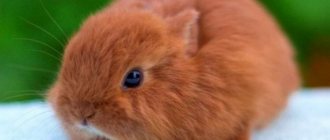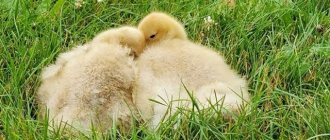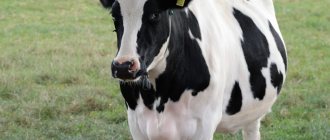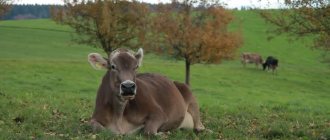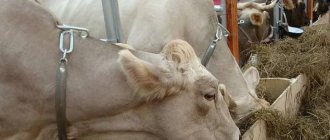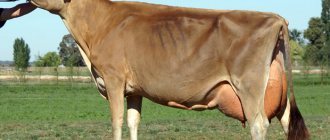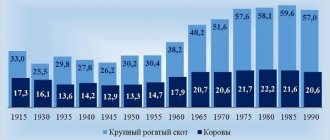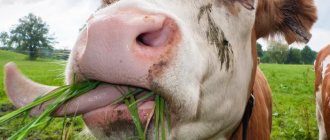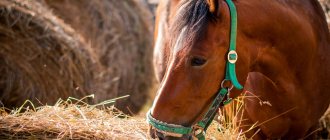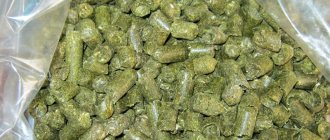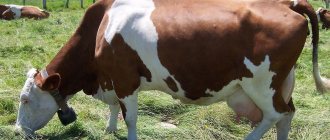Forage is food of plant origin that is fed to livestock. Previously, the word “fodder” was applied only to horse feed, but later it began to be used for cattle and small livestock.
What is a forage cow? A forage animal is an individual that is given additional feeding to increase milk yield. In the days of state and collective farms, calculations were made to calculate the number of forage animals on the farm. This was necessary in order to determine the volume of the food supply. Calculations of milk yield per 1 forage cow were carried out. This was considered the main indicator that reflected the overall productivity of the dairy herd.
Forage cow and her milk yield
A correctly calculated milk yield per 1 forage cow will give insight into the results of farm operations. Such qualities of an individual as its breed and the breed of its ancestors, as well as the ideal shape of the udder (cup-shaped or bath-shaped), lead to good data. Cattle owners must create a special regime for feeding, milking and other activities. Their responsibilities include the ability to count the amount of milk collected. The article gives an idea of what cows are called forage cows and how to correctly calculate their milk yield.
Number of feed units per head of cattle
You can find out how many feed units of feed are required per head of cattle from the table below. Based on these data, the farmer can easily independently calculate the ration for his livestock and properly organize the fattening of cattle. The table shows the diet of an adult dairy cow: the name of the feed for cattle, its quantity and the same volume, expressed in the unit of measurement “feed unit”.
Nutritional value of feed, table for cattle:
| Silage, 30 kg | 6 KU (feed units) |
| Sugar beets, 5 kg | 1.3 KE |
| Wheat bran, 600 g | 0.5 KU |
| Sunflower cake, 1.5 kg | 1.6 KE |
| Meadow hay, 6 kg | 2.6 KE |
In reality, the data may deviate slightly from the standards in one direction or another (“plus” or “minus”), this is quite acceptable. Concentrated feed for cattle is considered the most nutritious.
Forage in feeding
The term "forage cow" is used in dairy farming . This expression comes from the name of the food that the animal eats. Based on such cows, the productivity of the herd is assessed - milk yield. It is usually determined a year in advance. Since farms usually have many heads of livestock, the average figure is calculated per cow.
Feeding forage cows must be complete, since the amount of milk produced depends on this. Forage is an additional complementary food that provides the cattle with protein. This is a substance without which the body cannot function well, and therefore the dairy cow must receive it in the required quantity.
Forage includes:
All this is considered additional feed, which is why dairy cattle began to be called feed animals. In the summer, the herd needs grazing on pastures, which will allow them to find food there throughout the warm period. This option alone can significantly increase the amount of milk per milk yield. A cow can consume forage both fresh and dried.
Mean square
The mean square is used for features expressed by linear measures of area. For example, to determine the average diameter of sunflower baskets, the size of leaves, the size of colonies of microorganisms, etc. Just like the arithmetic mean, the mean square can be simple and weighted.
where is the average;
x options;
n is a number option.
Let's consider the method for calculating the mean square.
Example 1. There is data on the length of 10 rabbit skins (Table 2.5).
Table 2.5
We invite you to read: Mammoths - ancient prehistoric animals
where is the average;
x options;
n is a number option.
Control milking method
Milk is a healthy and tasty product from which you can make kefir, sour cream, and butter. All this is valuable in the nutrition of adults and children. That is why in agriculture such attention is paid to calculating the resulting product. Various formulas and methods have been created. All this is necessary in order to determine how productive cows are, because they are assessed precisely by their milk yield per year and per lactation.
If you weigh the milk received every day, you will get the most accurate number. However, such a process is very labor-intensive, because farms can have hundreds of heads of cattle. In this regard, a method of control milking was determined at certain time intervals, for example, after 5 days, 10 days or 30. The shortest interval between them will give a more accurate result. To determine milk yield for this period, multiply the amount of milk collected on the control day by the number of days in the period. Next, the amounts for the periods are added up, and the result of milk yield for the year or for lactation is obtained.
Conflict with Lindsay Lohan
In 2010, one of Pitbull's lines, in which he used the name Lindsay Lohan in a comparative phrase, caused a stir. The line took place in a song called Give Me Everything from Planet Pit's sixth album.
The matter did not end with just outrage - Lohan filed a lawsuit against Perez. She demanded monetary compensation. Firstly, for using her name at all. Secondly, because this line could have caused damage to her career, because it carried a negative character. As a result, a judge dismissed Lohan's claim because the lyrics were protected by the First Amendment. At this point the case was closed.
Calculation of milk yield of forage cows
To calculate the annual milk yield per forage cow, you must follow the formula where the total milk yield is divided by the average number of cows per year. In order to carry out such calculations, employees of farms and agricultural enterprises must make records of milk yield. In the statistics journal they write data about the collected amount of milk per cow and for all cows together per day or for a selected period.
For example, you can understand that if there is one cow on the farm, and it will be milked within one year, then this is the milk yield for this period. On farms there are sometimes several hundred heads of cattle and counting is quite labor-intensive. Over the course of a year, the number of cows may change, or some individuals may not produce milk, so the average milk yield per cow is calculated. You can also divide the annual amount of milk by the number of cows supplied for rationing. This means that they received fodder. This is how milk yield per feed cow is determined. Typically this number is slightly less than that of one dairy cow.
By studying the data obtained from the calculations for different periods, agricultural and farm workers can understand how things are going there. When making calculations, it is necessary to take into account not only feed, but also human labor and production.
If the information in the article was useful to you, please like it.
Please tell us what you think about this.
Source
Types of dairy breeds
Depending on the purpose of keeping cattle, the main distinctive features of existing breeds are determined. Meat animals make it possible to obtain a large amount of meat during slaughter, but little milk is obtained from such animals, although it is characterized by high fat content. High-yielding cows belong to dairy breeds, but their exterior will not allow them to produce a lot of meat.
The most common and productive dairy breeds are Holstein dairy, Red Steppe, Kholmogory, Aishir, Dutch, Black-and-White, and Yaroslavl. They differ in appearance, performance and degree of adaptability to the climate.
Holstein
The homeland of this breed is the USA and Canada, where they are most common. The coat color is black and white, weight is from 650 to 750 kg. Milk yield depends on the climate of the region and is about 7.5 tons per year. The fat content of the resulting milk is 3.8%. Moreover, in some countries it is possible to obtain over 10 tons of milk per year, but its fat content is reduced to 3.7%.
Red steppe
The basis for the development of this breed was the cows of the steppe zone of Ukraine. The period of its breeding goes back more than two hundred years. It is most adapted to drought and heat and is unpretentious in maintenance. The color of the animal's fur is brownish-brown. Weight ranges from 450-500 kg. The milk produced by a cow of this breed is 3.5-4 tons per year, the fat content is 3.7-3.9%.
Kholmogorskaya
An original Russian breed, popular in central Russia. She is distinguished by her tall stature, good muscle development and black and white variegated coat color. Adapts well to new conditions. The weight of a cow ranges from 480-590 kg. Milk yield and quality of milk are good: with proper care, it produces up to 4.5 tons per year with a fat content of 3.9-4%.
Aishirskaya
Its homeland is Scotland, the breed is widespread in North America, Eurasia and Australia. It tolerates cold climates well, so it is popular in Finland and the northern regions of Russia. It is distinguished by its red-motley color, small stature and large build. The weight of an adult cattle is 480-600 kg. It produces 7-8.5 tons of milk per year, its fat content is 3.9-4%.
Dutch
The oldest purebred cattle breed, which is the most widespread in the world. Initially, their breeding was focused on producing beef, but gradually breeders achieved high milk yield. There are three subspecies of these cows: Friesian (black and white), Groningen (black or red with a white head) and Maas-Rhine-Isel (red and white). It has a good milky exterior, a large udder with large regular nipples. The weight of a representative of this breed is about 550-750 kg, productivity is 4.5 tons of milk per year with a fat content of 3.8-4%.
Black and white
It appeared relatively recently as a result of crossing the East Friesian and Dutch breeds. It got its name due to its color. It has a strong build, a pronounced milky exterior, a cup-shaped udder with closely spaced rear teats. Live weight ranges from 550-650 kg. It has good productivity: it produces from 4 to 6 tons of milk per year, the protein value of which is 3.6-3.7%.
A black-and-white cow produces 4 to 6 tons of milk per year
Yaroslavskaya
A good dairy breed of cows bred in Russia. It is medium in size, with a wide body, narrow head and long legs. The coat color is black with white spots on the head, around the eyes, lower abdomen, legs and tail. The weight of an adult reaches 550 kg. Milk yield reaches 3-3.5 tons per year. Milk has high fat content, reaching 4.5%.
Nutrition
The diet of cows is determined by the group in which they are currently located. In livestock farms, cows are usually divided into:
Dairy cows, on whose nutrition not only their milk yield depends, but also the productivity of the farm as a whole, have the most varied and protein-rich feed. The more milk they give, the more food they get. These cows largely feed on forage, which is why they are often called forage animals.
“Neglected” individuals must take care of healthy offspring, so their food is rich in vitamins and proteins.
At first, post-calving animals receive large quantities of hay and water, then gradually succulent feed is added to their diet.
When determining the efficiency of dairy farms, it is customary to calculate not only milk yield, but also the amount of feed consumed. Correct and timely division of animals into groups can significantly reduce feed costs and increase performance.
For these purposes, livestock breeders usually keep a calendar, where they keep a daily record of the number of animals in each group. This further helps in planning groups and calculating the required supply of feed.
Daily requirement
All rules for formulating a diet are based on the daily requirement of the cow’s body for certain microelements and vitamins. It should be remembered that this figure depends on the productivity of the animal. The more milk an animal gives, the more nutrients and vitamins it needs. If the diet does not meet the animal’s needs, it will lead to a decrease in milk production and the body’s protective functions.
This article will tell you about keeping cows at home.
In vitamins
Vitamins play a regulatory role in the animal's body. Their lack leads to a decrease in appetite and, as a consequence, to a drop in milk yield. For dairy cows, the most important is vitamin A, which requires at least 50-70 mg per day. Vitamin C is important to improve overall health, up to 60 mg per day. Among the B vitamins, B1 plays the most important role; it should be included in the diet in an amount of 30-40 mg per day. To improve performance, the vitamin complex should include up to 300-500 mg of vitamin E.
In trace elements
It is impossible to calculate the exact amount of certain microelements in food. For this reason, when creating a diet, you need to add a constant amount of these substances to it. This will provide the cow with everything necessary for healthy milking and will not lead to an overabundance of these components. The following should be added to the general daily menu of a dairy cow:
- 2 grams of magnesium;
- 6 grams of calcium;
- 4 grams of phosphorus;
- 5 grams sodium.
How are grains and legumes processed for feed?
The process of preparing forage feed is considered complex. For this purpose, grain types of feed mixtures are subjected to the following types of mechanical processing:
Legumes are preliminarily subjected to heat treatment. They are steamed in hot water to destroy harmful substances. In this case, deep containers are used. Here the beans and corn are kept for 10 hours.
Hydroponic technologies are used to obtain plant mass. Herbs are grown in closed greenhouse conditions. Already on the seventh day from the moment of planting, experts add green mass along with root residues. These products contain high levels of carotene and protein. Thanks to these ingredients, the nutrient substrate acquires volume and juiciness.
Peculiarities
The number of forage cows on large farms and private farmsteads is growing year by year. And this is understandable, because the use of forage feed can increase the daily milk yield from each cow by at least 0.5 liters. How much will this be in terms of the herd? It is estimated that on average one forage cow can produce up to three thousand liters of milk per year - and this is a very good indicator.
A competent approach to the formation of groups of animals opens up wide opportunities for financial savings and increasing the profitability of the farm. The higher the productivity of individuals, the more attention it attracts from dairy producers and cattle buyers.
It is much safer and more promising to purchase animals from a successful owner.
You can see how to increase milk yield in the following video.
Forage is a type of plant food that is widely used as the main food for cattle. At the beginning of the last century, forage feed was used to feed horses. However, its valuable composition helped improve the quality of milk and meat. Since then, farmers have begun using it as an additive to grain mixtures.
Diet preparation
In order to create a competent, complete diet for an animal, it is not enough to know about its components
No less important is knowledge of the proportions and the exact amount needed by the animal per day. When preparing your diet:
- in winter, the bulk of the total diet should be roughage;
- In summer, freshly cut grass is used as additional feeding; it should be given after flowering has completed;
- take into account the productivity of the animal, the greater its daily milk yield, the more succulent feed is needed;
- if the milk yield is more than 10 kg of milk per day, mineral and vitamin supplements must be introduced;
- per day the animal requires at least 30 kg of hay, silage, humic feed (this is their total mass);
- fresh vegetables and root vegetables account for no more than 6 kg.
What is a forage cow?
A similar name is used in relation to animals that are used to obtain regular milk yield. Dairy cows are fed with forage feed.
Experts say that forage is considered an excellent protein supplement. It uses high-quality plants, legumes and grains. These ingredients provoke excellent metabolic processes in the animal body.
Important! The high level of protein molecules in the mixture stimulates the functioning of the animal's mammary glands. Dairy products are high in fat and rich in vitamins.
Bone joints, muscular system
The elasticity and strength of the skeleton, the smooth movement of the cow is formed thanks to high-quality “inserts” between the bones. This function is performed by collagen fibers that form ligaments. They withstand heavy loads, forming continuous strong joints of limited mobility and joints.
The joints have a special two-layer capsule. Inside it, the bones are lubricated with synovial fluid and do not rub against each other. This increases the amplitude of movement of the cow’s limbs and head. Such formations strengthen the internal ligaments. Externally, the joints are partially supported by muscles.
Among diseases of the skeletal organs of cattle, joint diseases have become widespread, leading to limitation of movements and severe pain.
Muscle tone characterizes a healthy animal. It is created by skeletal muscles outside and smooth muscles inside the body, ensuring intestinal peristalsis, effective functioning of internal organs, and vessels of the circulatory system. The skeletal muscles perform antagonistic functions: abductor and adductor, flexion and extension. There are about 250 such muscles in the body of large bulls, and the constitution of an adult individual is characterized by 47% muscle mass in relation to the total weight.
Feed consumption accounting
Feed calculations are based on feeding days. A special formula has been developed for this. It looks something like this: at the beginning of the month, the number of goals is taken into account. The indicator is recorded on the calendar. If the livestock is replenished with new cows, this will be displayed. The livestock that left the herd is also taken into account. They are also taken into account when calculating feed consumption, since they received forage before being transferred to dry land.
Such calculations help predict feeding days and determine the number of individuals that will receive forage feed, how many will go into dry wood, and how many will come to the dairy group. The results of the calculations also determine how much feed needs to be prepared for animals being fed.
On a private farmstead, as well as on small farms, it is easy to determine the amount of feed to feed one forage cow. But calculating how much is required for adequate nutrition of animals in large and medium-sized farms is more difficult.
What are the requirements for the product?
There are certain requirements for feed wheat. International quality standards and GOST allow any variety and type of wheat, but strictly regulate the following indicators:
- Appearance. The grain must be healthy, have normal color and shape. There should be no smell of mold, rot, malt, etc.
- Impurities. In the total mass of feed wheat, it is not allowed to contain more than 15% of other grains, more than 1% of weed seeds, and more than 3% of mineral waste.
- Infection with fungal diseases. The grain affected by fusarium should be no more than 1%, and up to 10% by smut fungus. Infection with other diseases is not allowed.
- Presence of pests. The fodder should not have any pests in its total mass. Damage by insects and microorganisms that can harm livestock is not allowed.
- Humidity. This figure should not exceed 15%.
Forage in feeding
The term "forage cow" is used in dairy farming . This expression comes from the name of the food that the animal eats. Based on such cows, the productivity of the herd is assessed - milk yield. It is usually determined a year in advance. Since farms usually have many heads of livestock, the average figure is calculated per cow.
Feeding forage cows must be complete, since the amount of milk produced depends on this. Forage is an additional complementary food that provides the cattle with protein. This is a substance without which the body cannot function well, and therefore the dairy cow must receive it in the required quantity.
Forage includes:
All this is considered additional feed, which is why dairy cattle began to be called feed animals. In the summer, the herd needs grazing on pastures, which will allow them to find food there throughout the warm period. This option alone can significantly increase the amount of milk per milk yield. A cow can consume forage both fresh and dried.
Theoretical foundations of livestock production (I. V. Sitnikova, 2012)
The guidelines provide the procedure for performing laboratory work, test questions, and a dictionary of terms and definitions. Reference material is provided.
Table of contents
- INTRODUCTION
- Topic 1 Assessment of farm animals by appearance and constitution
- Topic 2 Accounting for animal growth and development
- Topic 3 Assessment of meat productivity of animals
- Topic 4 Accounting and assessment of milk productivity of cows
- Topic 5 Classification and chemical composition of feed
The given introductory fragment of the book Theoretical foundations of livestock production (I. V. Sitnikova, 2012) was provided by our book partner - the liters company.
Topic 4 Accounting and assessment of milk productivity of cows
Purpose of the lesson:
study economic indicators of quantitative and qualitative assessment of milk, methods of their accounting.
Milking control
Milk is a healthy product used to produce a wide variety of fermented milk products, sour cream, cheeses, cottage cheese, and butter. It is highly valued.
On farms, the milk productivity of cows is constantly determined using various formulas and calculations. This is necessary to find out how productive each cow is individually, since milk yield is calculated for the year and for the lactation period.
To obtain the most accurate results, milk is weighed daily. But such work is carried out only on small farms where the number of cows is not large. In large livestock farms, control is carried out every few days at certain intervals. To know how much milk the cows gave during the period between weighings, the data obtained on the control day is multiplied by the number of days in the interval. Then all the amounts received for the year are added up - the annual yield is obtained. The same principle is used to determine milk yield during lactation.
general information
Each person buys a cow based on his financial resources.
A good thoroughbred cow costs at least 1 thousand dollars. But not everyone can afford such an acquisition. Therefore, crossbred or outbred cattle are often purchased. If you have the opportunity to purchase a purebred animal, it is recommended to opt for the following dairy breeds: These breeds are highly productive, milk yield is more than 6 thousand liters per year. Milk fat content is high.
How is milk yield calculated?
To determine the quality of the dairy stock and the intensity of productivity, the milk yield per 1 forage cow per year is determined. To do this, certain calculations are performed. Using source data:
Analyzing the calculation results, it is determined that the indicator is high for a dairy cow. The farm is considered to be of high quality. The use of food resources is efficient. If the results of milk yield assessment are underestimated, the diet, the method of keeping the livestock, and the individual characteristics of the cattle breed are analyzed. Sometimes they come to the conclusion that the livestock needs to be updated with individuals from other breeds that are famous for their milk productivity.
Data on dairy herd estimates is needed not only for dairy farmers. They are transferred to state statistics, where they provide an assessment of the state of livestock farming in the country. In addition, good farm performance is a good advertisement for cattle buyers and dairy producers.
Bibliography:
Zebu - humpbacked cattle
Zebu in the countries of the former USSR are common in Azerbaijan and the Central Asian republics. It is also sometimes called the Asian zebu. This species most likely originated in India. Its main difference is the muscle-fat hump.
Interestingly, its thick skin secretes an odorous oil that repels blood-sucking insects, and the heat does not pose any threat to the zebu. In principle, this subspecies of bull-shaped animals lives precisely in hot countries - Asia, South America, Africa. Note that when crossing zebu with cows, excellent offspring are obtained.
Calculation of milk yield
In large farms, to calculate the average milk yield per forage cow, they use the formula where the total milk yield is divided by the number of heads in the herd. When it is necessary to find out how much milk a particular cow gave per day, the annual amount is divided by the days of lactation.
The information received is recorded in special accounting journals for the selected period.
For example, there are hundreds of cows on farms. Calculating how many liters of milk per day each individual produces is labor-intensive. Moreover, the number of cows changes; some cows may not produce milk. Because of these features, it is the average milk yield that is calculated. You can also calculate the volume of milk by the number of heads supplied for the feed ration. The latter calculation method allows you to determine the milk yield of forage cows. Most often it is less than the indicators of dairy cows.
By studying how to milk a cow and how much milk it produces over different periods, farmers can understand how well things are going. The calculations made help to take into account not only the costs of feed, but also labor, and calculate the possible profit from sales.
Udder condition assessment
It is important to pay special attention to assessing the condition of the udder and milk well. In a productive cow, it is large and has a bath- or cup-shaped shape. On top it is covered with a thin, delicate epidermis, the fur is thin and sparse. After the lactation period ends, the udder becomes significantly smaller in size; it is no longer dense to the touch, but soft, empty inside.
If a cow is unproductive, even after the cessation of lactation, her udder remains dense. All parts of the udder should be formed evenly. The shape of the nipples is conical or cylindrical, their length does not exceed 7 centimeters. Their walls are thin and elastic to the touch.
Important! Animals of low productivity are characterized by an asymmetrically formed udder. The nipples of such cows are too short or long.
